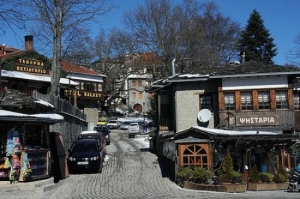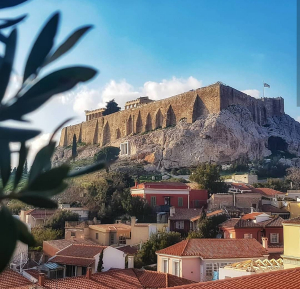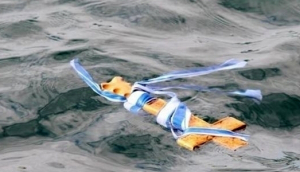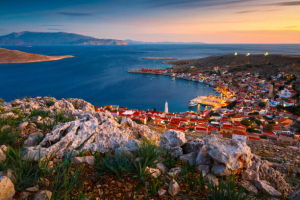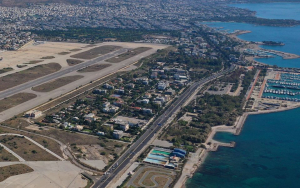XpatAthens
Top Things To Do In Metsovo, Greece
Glug Glug Bang Bang - Borsalino Bar
The Dalliance House Restaurant In Kifisia
Address: Kiriazi 19, Kifisia
Telephone: 210 62 30 775
Maximum Cash Withdrawal Limit Rises As Capital Controls Ease
March 13 - Springtime Outings In Athens
The Celebration Of Epiphany In Greece
Click here to listen to the song. If you are curious to see how children sing the Epiphany carols, click here.
On the morning of January 6th, people gather at a specific waterside location where the priest throws the cross in the water. Depending on the region, the cross is thrown in the sea, river, or lake. In mountainous areas or in Athens, the cross can also be thrown in a fountain.
The Epiphany tradition goes back to ancient Greece, and particularly to a feast which was called “Plintiria” (=washing machines). During this feast, the Athenians carried the statue of Athena to the coast of Faliro (close to Piraeus) to wash it in the sea, to make sure it would keep its magic powers.
Don't forget that on January 6th, a lot of people have their Name Day as well: Fotis, Foteini, Theofanis, Theofania, Fani, Ourania, Iordanis. You can wish them: Xronia Polla! Χρόνια Πολλά!
If you want to learn other Greek wishes you can use for Name Days, National Holidays or Social Occasions, you are welcome to download the “Greek Wishes For Social Occasions” FREE eBOOK, including Audio for the correct pronunciation.
Omilo Greek Language and Culture inspires people from all over the world to learn Greek, while exploring Greece. They offer 1- and 2-week courses for adults that combine beautiful course locations, experienced teachers, and a balanced combination of Greek classes with cultural activities. All these make Omilo a place where people enjoy learning modern Greek and have fun.
Besides the courses, Omilo also creates online publications to help adults expand their language skills through Language Books and eBooks for different language levels.
Halki Island To Turn Green
The Best-Kept Secret Of Acropolis
The secret chamber of the Acropolis is actually a Byzantine church. Restored in 2017, the Acropolis, once a place of worship, burrows deep into the base of Athens’ most renowned mountain. Above the Dionysus Theater, is the church called Panagia Spilotissa, or the Virgin Mary of the Cave, which was converted from an archaic temple.
Ironically, the church originated as a temple to celebrate the ancient Greek god of festivity and religious madness. Dating back to 320 BC, the cave was a temple dedicated to Dionysus, built by Thrasyllos. Two Ionian pillars still stand on top of the entryway, easily spotted from the pedestrian walkway, the Dionysios Areopagitis, that borders the Acropolis.
Acropolis’ Secret: First an Archaic Monument, Then an Alternative Church
The monument was erected to celebrate Thrasyllos’ victory as the benefactor of a chorus that performed in the annual dramatic festival that honored Dionysus. After the victory, Thrasyllos had the monument constructed. It was again modified in 297 BC, following his son, Thrasyklis, victory to include inscriptions.
The cave was most likely considered sacred long before the construction of the monument. It may have been dedicated to Artemis, the goddess of the hunt. The rock face was cut back to form a flat vertical surface, and the mouth of the cave was enlarged into a rectangular opening. Two broad stone steps led up to the entry.
A Doric marble portico was set at the front of the cave, in imitation of the Propylaea, on the southwest wing of the Acropolis. The structure would have been surmounted with three bronze tripods that served as the actual prizes in the annual competition that involved drama, comedy, and musical performances. The tripods were eventually replaced with a statue of Dionysus.
Best-Preserved Examples of post-Byzantine Hagiography
“The fresco decoration of Panagia Spiliotissa comprises the best-preserved examples of post-Byzantine hagiography in the area of the Acropolis and its slopes,” according to Dr. Konstantinos Boletis. Boletis serves as a restoration architect for the Department/Ephorate of Antiquities of the City of Athens.
The church was one of the “alternative” places to worship that began to emerge in Athens during the sixth century following the decrees sent down by the Byzantine emperors.
To read this article in full, please visit: greekreporter.com
Transforming Athens: The Rise of Europe's Largest Smart City Project
Originally published in Greek on: newsbeast.gr
The National Marine Park Of Zakynthos
Zakynthos is one of the most important loggerhead sea turtle Caretta caretta nesting areas in the Mediterranean. Finding refuge in the marine area of the Bay of Laganas is actually a matter of survival for this beautiful but critically endangered species. Caretta caretta reaches Zakynthos in summer after having travelled thousands of kilometers across the Mediterranean territory.
During oviparity period, the female turtles head to the shore at night and dig with their back fins big holes in the sand, where they place 120 small eggs the size of ping pong balls. They then head to the sea leaving behind their traces in the sand, a sign that marks the holy ritual of birth.
After forty to sixty days the first eggs begin to “burst”. The little turtles remain protected for a few days more in the warmth of their nest until their body takes its final shape. A strong memory instinct will lead them back to the sea, where they will embark on their fascinating journey of life. They may return—adults this time—to breed and nest in the same place that they themselves were born. Unfortunately only one out of a thousand will survive since they will be exposed to many dangers, mostly associated with human activity. That is the reason why the Marine Park had been founded there in the first place.
For more information, please visit www.nmp-zak.org


